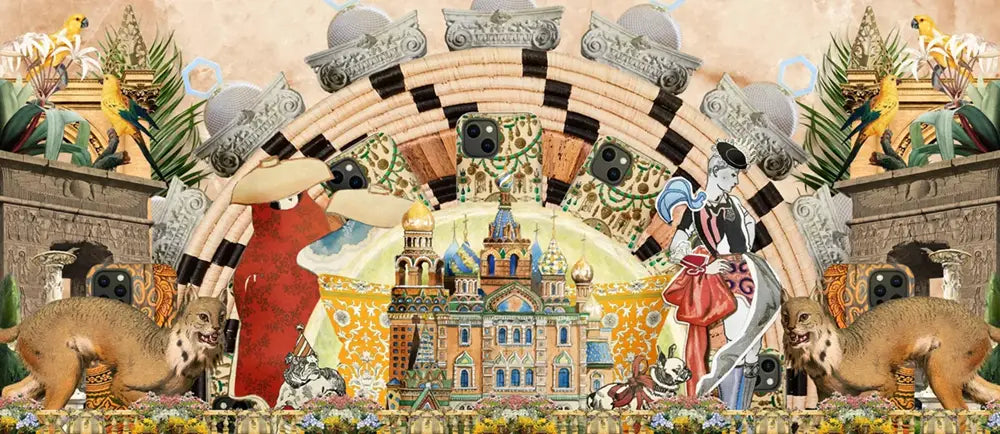The sun hovers just above Giza’s ridges as a pot seller wraps her day in clay and coin, each vessel a story carved by her hands. Baumann didn’t dream this scene—she unpacked her easel on the sands, sketching a working woman whose quiet strength radiates like heat off a fired jar. Here, in that suspended instant, labor becomes lyric and earth turns to epiphany.
Key Takeaways
- Feel how Baumann’s layered glazes summon the rough warmth of clay, turning every pot into a tactile hymn of desert labor.
- Trace how this portrait elevates a humble vendor into an emblem of self-possession, upending centuries of male-crafted harem fantasies.
- Witness the painting’s structural dialogue—arched spines and stacked jars mirroring Giza’s pyramidal silhouettes in quiet harmony.
- Uncover how light and shadow choreograph a silent drama, each fold of fabric and glint of coin mapping the intersection of material and memory.
- Emerge with fresh insight into Baumann’s radical choice: to paint not from a studio invented East, but from footprints pressed into Egyptian sand.
Desert Light and Painted Breath: Anatomy of a Clay-Born Ode
Elisabeth Jerichau-Baumann’s An Egyptian Pot Seller at Gizeh arrests time in a single, sunlit frame—an Orientalist brushwork marvel bathed in a Giza dawn palette.¹ The tent’s swaying drape becomes a hushed prologue, framing a peasant woman whose repose feels both intimate and exalted. She lounges atop richly patterned carpets, each thread woven with insistence, as if demanding to be felt. The scene vibrates at the threshold between labor and lyricism.
Her posture reads like a silent sonnet.² One elbow props against a coiled jar; the other hand traces the tent’s fringe as though mapping memory. Baumann’s touch shifts from razor-fine to exuberant sweep—every pendant in her necklace caught by translucent veil glazing, every fold of cloth choreographed in pigment. The veils hover above bronze skin, their gauzy layers drawn with academic glazing technique that reveals and conceals in tandem.
A chorus of sunbaked ochres and siennas sweeps into dusk-blue robes and the pearl glow of linen.³ Light spills through fine fabric, scattering diamond-dust highlights across clavicle and collar. Impasto texture crowns the carpet fringe and the earthen pot’s rim, inviting fingertips to wander over canvas grain. Faces and hands gleam with polished precision; elsewhere, the brush breathes freely, suggesting desert wind at her feet.
Curves and pillars hold the composition in taut equipoise.⁴ The woman’s spine arcs like a shoreline; the stacked jars rise as silent columns. The pyramids slip into misty distance on a low horizon, anchoring depth without distracting from her stillness. Perspective tilts so we nearly taste the heated air that ripples across the scene. In every stroke, technique and vision intertwine—drawing us into a private encounter with a world both real and reimagined.
Reading List
-
Ronald Varney, A Museum Discovery, Faviconronaldvarney.com.
-
Wikipedia, “An Egyptian Pot Seller at Gizeh,” Faviconen.wikipedia.org.
-
National Museum of Women in the Arts, Search for the Spectacular: Elisabeth Jerichau Baumann, Faviconnmwa.org.
-
Metropolitan Museum of Art, Orientalism in Nineteenth-Century Art, Faviconmetmuseum.org.
-
Sartle – Rogue Art History, “An Egyptian Pot Seller at Gizeh,” Faviconsartle.com.
Nordic Footprints in Ottoman Halls: Baumann’s Eastern Reckoning
Europe’s brush first turned eastward in 1798, when Napoleon’s army tramped across Egypt and unleashed a torrent of travelogues that painted the Orient into Western dreams.¹ Architects and painters devoured the Description de l’Égypte, its plates whispering of pyramids, bustling bazaars, and Ottoman courtyards. By mid-century, that fever for Near Eastern color had become a full-blown vogue—an artistic gold rush that lured painters into desert light.
Into that throng strode Elisabeth Jerichau-Baumann, a Polish Dane whose compass pointed to Constantinople in 1869.² She arrived draped in Nordic reserve and left armed with sketchbooks full of harem doorframes and palace corridors. The Ottoman elite, intrigued by her rarity—a woman with royal invitations—granted her entry into spaces barred to male peers. She painted Princess Nazlı Hanim from life, her palette absorbing silks and shadowed alcoves that most fantasists could only dream.
A second pilgrimage followed in 1874–75, when Baumann crossed from Greece into Egypt itself.³ In Giza’s fading light she studied fallahin at work—pot sellers, weavers, water carriers—scratching the surface of Oriental myth with the scratch of her brush. Her canvases emerged not from imagination’s haze but from tangible encounter: the patina of sunbaked bricks, the ripple of a tent flap, the glint of coin necklaces hanging at a woman’s throat.
That insistence on firsthand seeing set her apart.⁴ Male Orientalists often leaned on secondhand accounts or studio props; Baumann carried a passport and a painter’s eye. Her Pot Seller belongs to a rarified circle of works forged in the fire of lived experience—each stroke a footstep taken across shifting dunes.
Reading List
-
Metropolitan Museum of Art, Orientalism in Nineteenth-Century Art, Faviconmetmuseum.org.
-
National Museum of Women in the Arts, Search for the Spectacular: Elisabeth Jerichau Baumann, Faviconnmwa.org.
-
Canvas Journal, “Pleasure and Parody in the Harem: Elisabeth-Jerichau Baumann’s Encounter with Princess Nazli Hanim,” Faviconcanvasjournal.ca.
-
Ronald Varney, A Museum Discovery, Faviconronaldvarney.com.
-
Wikipedia, “An Egyptian Pot Seller at Gizeh,” Faviconen.wikipedia.org.
Shards of Reflection: A Woman’s Gaze in Orientalist Shadows
In the glaze of Orientalist scholarship, women often appear as phantoms of male desire—harem denizens draped in cliché.¹ Baumann’s Pot Seller retorts with an insurgent optics. Her sitter holds our stare like a mirror shard, reflecting back our own exoticizing gaze. The layered veil and coin necklace speak of authenticity, not fantasy, drawn from notebook sketches made inside Constantinople’s inner chambers.
That deliberate authenticity unsettles expectations.² Edward Said argued that Western art cast the Orient as sensuous territory ripe for conquest; here, Baumann redirects that narrative. Her model is not an object of pity or profit but a working woman who commands space and scrutiny. In this tableau, the female gaze becomes a counterpoint to male fantasy—each eye-lock a rebellion against centuries of studio props and borrowed costumes.
Baumann’s diary reveals her conviction: painting sensuality requires painterly courage.³ She wrote that art must “observe with the senses and employ them as the means to enjoy sensuous creations,” refusing to sterilize flesh into mere allegory. The transparency of the sitter’s tunic is galvanized by that credo—it is neither pornographic display nor chaste abstraction but a lived testament to body and labor.
By choosing a fellahin rather than a princess, Baumann disrupts the pecking order of Orientalist tropes.⁴ The pot seller’s jewelry is humble—coins and amulets passed hand to hand—yet it gleams with personal history. This is sensuous academic painting at its most radical: the erotic framed within everyday dignity. In that quiet subversion, Baumann forges a feminine alliance with her subject, embodying a subversive Orientalist masterpiece that echoes long after the desert sun has set.
Reading List
-
University of Alberta Libraries, Orientalist Narratives and Gender, journals.library.ualberta.ca.
-
Edward Said, Orientalism, Faviconjournals.library.ualberta.ca.
-
Robert Simon Fine Art, “Jerichau-Baumann,” robertsimon.com.
-
National Museum of Women in the Arts, Search for the Spectacular: Elisabeth Jerichau Baumann, Faviconnmwa.org.
Pyramid Shadows and Pottery Clinks: Colonial Echoes in Clay
The pyramids hover like ancestral sentinels just beyond the tent’s fringe—mute witnesses to Egypt’s collision of epochs.¹ In 1876, the Khedivate balanced Ottoman tradition with European ambition. Steamships carved a trail through the newly opened Suez Canal, and postcards of Giza churned through Parisian printshops.² Baumann sets her pot seller at this fulcrum of old and new, her brush tracing the tension between ivory columns of empire and the ochre grit of daily toil.
This is not romanticized antiquity but lived modernity in pigment.³ Britain and France vied for influence in Cairo’s corridors of power even as local artisans shaped clay pots under the same sun that warmed the pharaohs’ stones. The woman’s coins glint with that geopolitical shimmer—tiny currencies of survival and exchange. In her posture, there is both rooted tradition and an unspoken question about who owns this moment.
At home in Denmark, Baumann’s conquest of royal salons reversed in hushed scandal.⁴ Queen Victoria had summoned her work; later, Danish curators hid those erotic canvases in vaults deemed improper. For decades the Pot Seller lay in shadow, its daring female gaze eclipsed by prudish censors. Only now does it emerge, battered by time yet unbowed—a survivor of institutional amnesia and moral siege.
Here, art becomes archaeological fieldwork.⁵ Each glaze and grain of sand holds a fragment of cultural dialogue between colonizer and colonized, painter and model, spectator and subject. Baumann’s canvas does more than depict; it excavates the subterranean politics of representation. The desert’s hush gives way to the clink of coins and the whisper of veiled resolve—a fresco of resistance framed in daylight.
Reading List
-
Wikipedia, “An Egyptian Pot Seller at Gizeh,” Faviconen.wikipedia.org.
-
Metropolitan Museum of Art, Orientalism in Nineteenth-Century Art, Faviconmetmuseum.org.
-
National Museum of Women in the Arts, Search for the Spectacular: Elisabeth Jerichau Baumann, Faviconnmwa.org.
-
Ronald Varney, A Museum Discovery, Faviconronaldvarney.com.
-
Canvas Journal, “Pleasure and Parody in the Harem: Elisabeth-Jerichau Baumann’s Encounter with Princess Nazli Hanim,” Faviconcanvasjournal.ca.
Embers of Agency: The Pot Seller’s Unyielding Gaze
In An Egyptian Pot Seller at Gizeh, Elisabeth Jerichau-Baumann welds firsthand observation to poetic insurgency. The glint of clay jars and coin necklaces becomes a manifesto of agency. Her sitter does not languish as ornament but stands, however reclined, as an emblem of self-possession. This portrait transcends exile and expectation, folding the politics of empire into the curve of a shoulder. At last, the pot seller’s gaze outlives the gaze upon her—unyielding, luminous, unforgotten.









